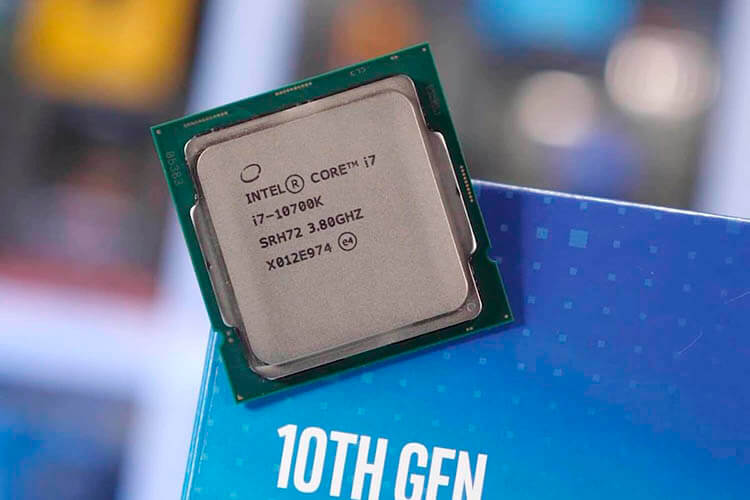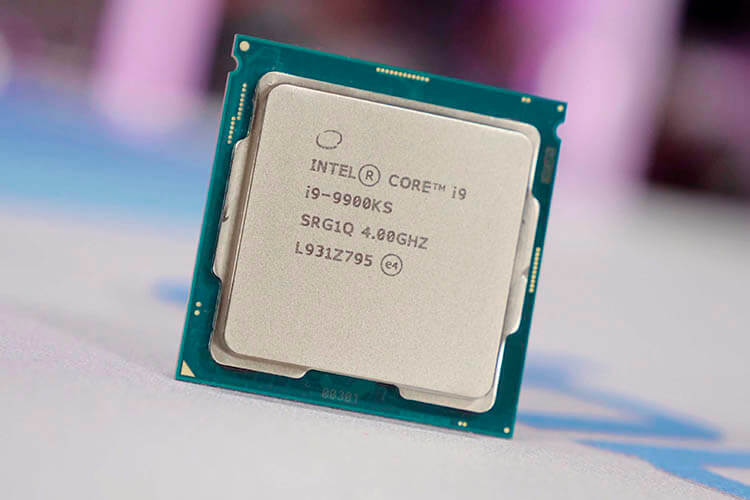Top 25 best Intel processors: ranking 2021-2022 for performance and what gaming processor to choose
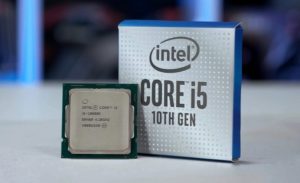 Most computers and laptops have an Intel processor - productive, powerful, fast, reliable and time-tested.
Most computers and laptops have an Intel processor - productive, powerful, fast, reliable and time-tested.
The variety of models of the brand is so great that you can choose the most suitable chip for your device, taking into account the number of cores, threads, the presence or absence of the graphics core, frequency and other parameters.
This review compiles the best Intel processor models according to customer reviews and ratings in 2021-2022.
Top 25 best Intel processors 2021-2022
This ranking includes powerful Intel processors for 2021-2022 suitable for different sockets.
| Place | Name | Price |
|---|---|---|
| Intel's Top 3 Best Value Processors for 2021-2022 |
||
| 1 | Intel Core i5-10400F | |
| 2 | Intel Core i3-9100F | |
| 3 | Intel Core i7-10700K | |
| Top 3 Intel processors for 1151v2 socket | ||
| 1 | Intel Core i5-9600KF | |
| 2 | Intel Core i9-9900 | |
| 3 | Intel Core i7-9700 | |
| Top 3 best low-cost Intel processors for socket 1200 | ||
| 1 | Intel Core i9-10900K | |
| 2 | Intel Core i5-10600 | |
| 3 | Intel Core i7-10700 | |
| Top 3 best Intel processors for 1151 socket | ||
| 1 | Intel Core i5-7400 | |
| 2 | Intel Core i3-7100 | |
| 3 | Intel Core i7-7700K | |
| Top 3 Intel processors for 1155 socket | ||
| 1 | Intel Core i3-3220 | |
| 2 | Intel Core i7-3770 | |
| 3 | Intel Core i5-3550S | |
| Top 3 best Intel processors for 2066 socket | ||
| 1 | Intel Core i9-10940X | |
| 2 | Intel Core i9-10900X | |
| 3 | Intel Core i7-7740X | |
| Top 3 best Intel processors for 2011 socket | ||
| 1 | Intel Xeon E5-2650V2 | |
| 2 | Intel Xeon E5-2630V2 | |
| 3 | Intel Xeon E5-2609V2 | |
| Intel's Top 2 Powerful Processors for 2011v3 Socket | ||
| 1 | Intel Xeon E5-1630 v4 | |
| 2 | Intel Xeon E5-2640 v4 | |
| Top 2 best Intel processors for 1150 socket | ||
| 1 | Intel Core i7-4790 | |
| 2 | Intel Core i3-4330 | |
Synopsis of
- Top 25 best Intel processors 2021-2022
- How to choose an Intel processor and what to look for?
- Top 3 best Intel processors by price/performance ratio
- Top 3 Intel processors for 1151v2 socket
- Top 3 best low-cost Intel processors for socket 1200
- Top 3 best Intel processors for 1151 socket
- Top 3 best Intel processors for 1155 socket
- Top 3 best Intel processors for 2066 socket
- Top 3 best Intel processors for 2011 socket
- Intel's Top 2 Powerful Processors for 2011v3 Socket
- Top 2 best Intel processors for 1150 socket
- Which processor is better - AMD or Intel?
- Shopper Testimonials
- Useful Videos
How to choose an Intel processor and what to look for?
When buying a processor, you should consider the main parameters that determine the performance, power, speed of the device in which it will be implemented.
The main selection criteria in 2021-2022 are:
- number of cores and threads;
- clock (operating) frequency and maximum frequency;
- type of technological process;
- socket;
- bit size of CPU;
- cache size;
- heat dissipation, TDP;
- cooling system;
- graphics core.
Top 3 best Intel processors by price/performance ratio
The models in this selection combine good specs and perform well in performance, while being reasonably priced.
Intel Core i5-10400F
A six-core processor without integrated graphics, one of the best selling Intel products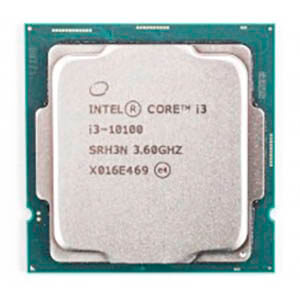
The chip has 12 threads, the third level cache is quite capacious - 12 MB. The device runs at a frequency of 2900 MHz, overclocking up to the maximum 4300 MHz. At the same time it does not heat up much and does not strain the howling sound: quiet, powerful and well cooled. The maximum frequency is possible thanks to the built-in Turbo 2.0 technology.
In this model, Hyper-Threading technology appears for the first time. The manufacturer claims the maximum operating temperature of 100 degrees, but tests have shown that even when running heavy applications the processor does not heat up more than 60 degrees. With a heat dissipation of 65 watts this is an excellent indicator.
Technical specifications:
- number of cores: 6;
- 14nm process technology;
- clock frequency: 2900 MHz;
- number of threads: 12;
- L3 cache size: 12 Mb.
- high-frequency memory operation;
- affordable price;
- does not heat up;
- performance.
- locked multiplier;
- requires good RAM.
Intel Core i3-9100F.
Budget quad-core processor with four approaches is a good "heart" for a home computer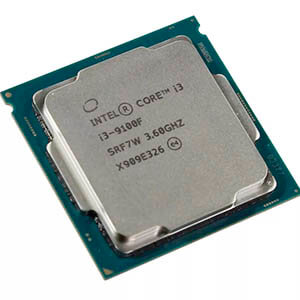
The operating frequency is 3600 MHz, and the maximum in Turbo mode is 4200 MHz. The bit rate of calculations - 64 bits, which is considered a good indicator.
According to customer reviews, the chip demonstrates excellent performance, high reliability, good speed and power performance and is suitable for most standard tasks.
A unique distinction of the model is the OEM-completion, which gives the buyer the right to choose a cooling system. In this case you should consider the heat dissipation of the processor at 65 W and the maximum operating temperature of 100 degrees.
The processor is based on the Coffee Lake architecture.
Technical specifications:
- number of cores: 4;
- process technology: 14 nm;
- clock speed: 3600 MHz;
- number of threads: 4;
- L3 cache size: 6 MB.
- low cost;
- suitable for video games;
- built-in memory controller;
- cooler included;
- does not heat up.
- Only compatible with 3xx series chipsets.
Intel Core i7-10700K
High-performance and fast processor with 8/16 cores equipped with LGA 1200 socket.
Eight cores, high clock frequency that can increase up to 5100 MHz in turbo mode, and 14 nm process technology make this chip powerful, fast, versatile and able to cope with any task. It runs at 3,800 MHz under standard load and at 5,100 MHz in Turbo mode.
The device is 64-bit and its heat dissipation is quite significant - 125W. When assembling the computer, you need to take care of a quality cooling system: the processor has no built-in cooler.
The advantage of this model is the presence of a good graphics core, the frequency of which reaches 1200 MHz in turbo mode.
There is also support for DDR4-memory, which works in dual-channel mode, with a RAM capacity limit of 128 GB. The volume of the third level cache is 16 MB: this is an excellent figure that provides fast access to the necessary data.
Specifications:
- number of cores: 8;
- process technology: 14 nm;
- clock frequency: 3800 MHz;
- number of threads: 16;
- L3 cache size: 16 MB.
- overclocked up to 5100 MHz;
- Intel vPro support;
- maximum operating temperature: 125 degrees;
- integrated graphics core;
- good FPS in games.
- price;
- heat dissipation.
Top 3 best powerful Intel socket 1151v2 processors
Modern 1151v2 sockets are equipped with 300-series chipsets and support Intel Core 8th and 9th generation processors (Coffee Lake).
Intel Core i5-9600KF
Ninth generation six-core processor with 6 threads and 14nm process technology is great for home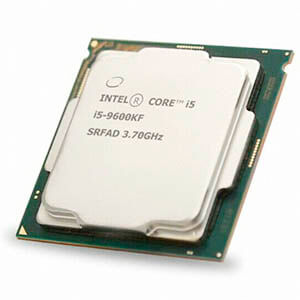
This is due to the high clock speed of 3700 MHz and the ability to booster up to 4600 MHz, providing fast and smooth operation at maximum load. However, the processor can make distinctive noises and get very hot, so you should take care of a good cooling system.
The core is based on the Coffee Lake-S architecture. Users note its power even when running online shooters, including - stable FPS without slumps. DDR4 RAM supports a frequency of 2666 MHz. The cache volume is 9 MB.
Technical specifications:
- number of cores: 6;
- TECHNOLOGY: 14 nm;
- clock frequency: 3700 MHz;
- number of threads: 6;
- L3 cache size: 9 MB.
- overclocked up to 4600 MHz in Turbo mode;
- built-in memory controller;
- large cache;
- performance speed;
- suitable for games.
- heat dissipation;
- Only compatible with 3xx series chipsets.
Intel Core i9-9900.
The ninth-generation processor, released in 2019, is designed for desktop computers and is suitable for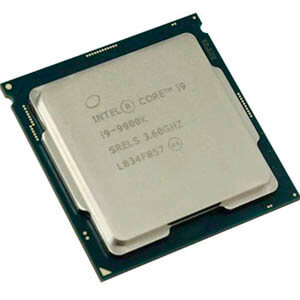
The maximum frequency in Turbo Boost is 5000 MHz. The processor heats up at these frequencies is very weak: heat dissipation is only 65 W, so with a good cooling system neither overheating nor the noise of the device is a threat.
The device is equipped with a standard cooler. In general, the processor can run right out of the box: this is provided by an integrated UHD 630, 1200 MHz graphics core with a maximum memory capacity of 64 GB. The total size of DDR4-2666 RAM, which the processor supports, is 128 GB.
Technical specifications:
- number of cores: 8;
- process technology: 14 nm;
- clock speed: 3100 MHz;
- number of threads: 16;
- L3 cache size: 16 MB.
- overclocked up to 5100 MHz in boost;
- Intel vPro support;
- integrated graphics;
- performance;
- cache capacity.
- price;
- locked multiplier.
Intel Core i7-9700.
Ninth-generation processor with 8/8 cores based on the Coffee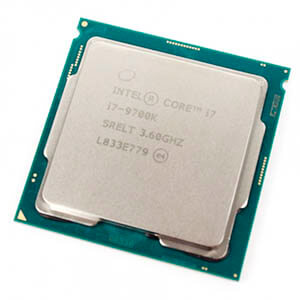
It supports DDR4 memory up to 128GB and runs at up to and including 2666 MHz. The clock frequency is 3000 MHz, which is quite enough for everyday tasks, immersion in web space and gaming activities.
The manufacturer promises 65W heat output, and a cooler is included with the purchase of the processor in the BOX package. There is a built-in memory controller with 41.6 GB/s bandwidth and 2 memory channels, as well as a roomy L3 cache.
According to user reviews, the processor proves to be very productive and powerful, but only in the initial stages of a strong load. That is, as soon as the device gets hot, its speed gradually decreases.
In order for the chip to remain in excellent condition even with prolonged loading, you need to use a high-quality thermoplastic with a good heat exchanger.
Technical specifications:
- number of cores: 8;
- 14nm process technology;
- clock speed: 3000 MHz;
- number of threads: 8;
- L3 cache size: 12 Mb.
- there is a graphics core;
- Intel vPro support;
- good overclocking;
- operating speed;
- L3 cache size.
- Performance decreases when heated.
Top 3 best inexpensive Intel processors for socket 1200
Processor socket code 1200 is Intel's most advanced socket, designed for Intel processors with the Comet Lake microarchitecture.
Intel Core i9-10900K
Super-performance and very powerful processor of the tenth generation is one of the leaders in
Its core performance is 10/20, and the process technology is 14 nm, which makes the Core i9-10900K one of the best gaming processors. The crystal is based on the Comet Lake-S microarchitecture and its own UHD 630 graphics core with 1200 MHz, which becomes quite a worthy alternative to a discrete graphics card.
There is nothing to complain about in this model: the clock frequency is steadily kept at 3700 MHz, overclocking in multi-tasking up to 5300 MHz in boost, memory controller with a limit of 128 GB, third level L3 cache 20 MB. These characteristics allow us to confidently call the chip a professional one.
The weak point is the heat dissipation of 125 W, so the "native" cooler may not cope with the cooling. However, this disadvantage is compensated by Intel vPro support - a unique development for automatic computer diagnostics.
Specifications:
- number of cores: 10;
- 14nm process technology;
- clock frequency: 3700 MHz;
- number of threads: 20;
- L3 cache capacity: 20 Mb.
- very powerful;
- stable, smooth overclocking;
- quickly removes information from the cache;
- handles heavy games and doesn't hang when multitasking.
- It heats up a lot.
Intel Core i5-10600.
A good six-core processor with Hyper-Threading technology and 12 processing threads,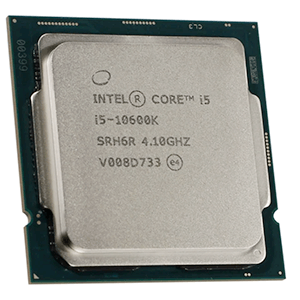
This crystal copes great with its tasks: office, everyday, graphics. And of all the tenth generation models, it is the best for gaming, even despite the locked multiplier.
The processor is equipped with dual-channel RAM DDR4-2666, but for running heavy applications and work with graphics is better to install a higher-frequency configuration.
The design includes an Intel UHD Graphics 630 graphics core, which is suitable for comfortably watching movies and TV shows, running games and three-dimensional modeling. The cooler is included in the delivery set BOX, but if you want more powerful cooling, it is better to choose the OEM variant and buy the cooler separately.
Technical specifications:
- number of cores: 6;
- 14nm process technology;
- clock frequency: 3300 MHz;
- number of threads: 12;
- L3 cache size: 12 Mb.
- it doesn't heat up;
- there is support for Intel vPro;
- proprietary graphics;
- price.
- An expensive motherboard is required.
Intel Core i7-10700
The premium octa-core processor is energy efficient, with optimal heat dissipation of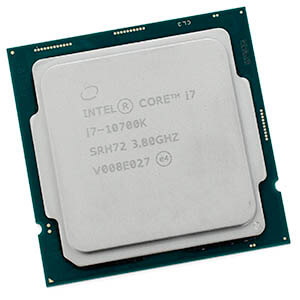
The core configuration looks 8/16, the cores are based on the Skylake microarchitecture. The crystal supports Hyper-Threading technology and has a third level cache of 16 MB.
The basis of the design is a semiconductor chip stepping Q0, which is produced on the 14-nm process. The total number of cores - 10, but 2 of them are blocked, as well as the multiplier, designed to accelerate.
The advantage of this device even in comparison with its closest analog Core i7-10700K is economy and heat dissipation of 65 W (against 125 W of the rival). This is explained, of course, by the blocked multiplier, due to which and the cost of the processor becomes affordable for most consumers.
Specifications:
- number of cores: 8;
- process: 14 nm;
- clock frequency: 2900 MHz;
- number of threads: 16;
- L3 cache size: 16 MB.
- brisk;
- does not heat up;
- economical;
- built-in graphics.
- noisy.
Top 3 best powerful Intel socket 1151 processors
The 1151 socket has a spring-loaded contact to make contact with processor pads and is compatible with SkyLake, Kaby Lake, Coffe Lake, and Coffee Lake Refresh processors.
Intel Core i5-7400
Seventh generation quad-core processor with four threads, good, budget and very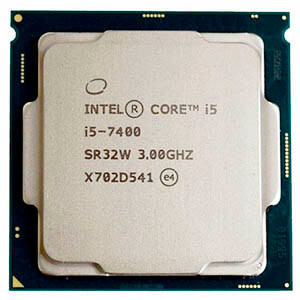
The basis is a core on the Kaby Lake-S microarchitecture with a rather modest clock speed of 3000 MHz. In Turbo Boost mode, the crystal is able to overclock up to 3500 MHz without excessive noise and excessive heat: heat dissipation does not exceed 65W.
At high load, the CPU speed is kept at 3300 MHz according to the test results. The chip also allows up to 64GB of DDR4-2400 MHz RAM in dual channel mode and takes advantage of the integrated Intel HD Graphics 630 graphics core in the absence of a discrete graphics card.
The CPU is ideal for a home gaming or work computer with optimal comfort levels in multitasking mode.
Technical specifications:
- number of cores: 4;
- process technology: 14 nm;
- clock speed: 3000 MHz;
- number of threads: 4;
- L3 cache size: 6 MB.
- budget;
- performance;
- does not heat up even under heavy loads;
- perfectly overclocks.
- Difficulty in upgrading.
Intel Core i3-7100.
Desktop dual-core processor with four threads and a working frequency of 3900 MHz is well suited for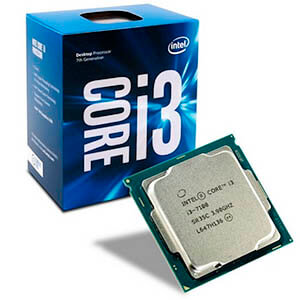
The high level of performance and good operating speed allows to avoid system hangs and errors, thanks to which efficiency and power are achieved.
Level 3 cache is small, 3 MB, which is why the processor will not be able to work with heavy applications. However, you can watch movies and TV shows or play light games.
In addition, the heat dissipation is only 51 W, so even with the simplest cooler the cooling will be effective. The maximum operating temperature is 100 °C.
The model is made according to the 14 nm process and is based on the Kaby Lake-S core.
Specifications:
- number of cores: 2;
- process technology: 14 nm;
- clock speed: 3900 MHz;
- number of threads: 4;
- L3 cache size: 3 Mb.
- integrated graphics;
- low heat dissipation;
- low cost;
- running speed.
- 2 cores;
- small cache.
Intel Core i7-7700K
The Intel Core i7-7700K processor comes at a time when everyone was expecting a new 10nm processor from Intel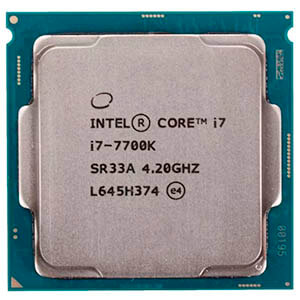
The second generation 14nm process is different in that the semiconductor chip structure has been slightly improved but the resolution of the lithographic process remains the same.
The basis of the chip are 4 cores on the Kaby Lake microarchitecture, which differs from previous architectures with increased clock frequency. In particular, this device works in normal mode at 4200 MHz, and in the turbo boost is overclocked to 4500 MHz. But such overclocking has its own consequences - heat dissipation of 91 W.
That's probably why Intel decided not to sell this chip in a BOX package, so the cooler has to be purchased separately.
But there is a good integrated graphics HD Graphics 630, 1150 MHz and memory controller.
Technical specifications:
- number of cores: 4;
- TECHNOLOGY: 14 nm;
- clock frequency: 4200 MHz;
- number of threads: 8;
- L3 cache size: 8 Mb.
- good clock frequency;
- high working speed;
- Excellent multitasking performance;
- fast overclocking;
- with a good cooler does not heat up.
- price;
- no cooler.
Top 3 best powerful Intel processors for socket 1155
The 1155 socket is a fairly old CPU socket designed for Sandy Bridge processors.
Intel Core i3-3220.
Powerful, fast, cool dual core Ivy Bridge (2012) processor with four threads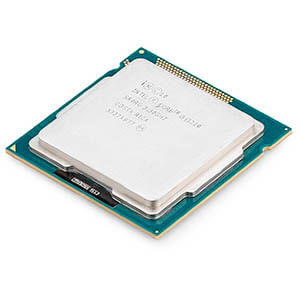
The high performance of the chip is provided by the clock frequency 3300 MHz and four threads. The heat output is small, so the device does not heat up during operation. At the same time, the maximum operating temperature specified by the manufacturer is only 65.3 °C.
A nice bonus to the purchase of this chip is a quality cooler, which copes with the cooling of the system.
Specifications:
- number of cores: 2;
- process technology: 22 nm;
- clock speed: 3300 MHz;
- number of threads: 4;
- cache size: 3 MB.
- budget;
- good manufacturing process;
- fast;
- built-in graphics;
- does not heat up.
- cache size.
Intel Core i7-3770.
A relatively inexpensive, efficient, powerful processor with a 4/8 core configuration and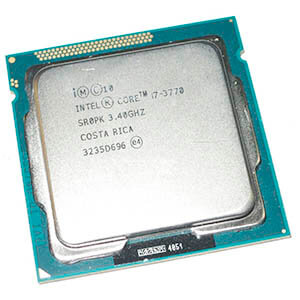
The model has 64-bit bit, 4 cores on Ivy Bridge architecture (2012) and an integrated graphics core HD Graphics 4000, 1150 MHz with good performance. In addition, the processor supports dual channel DDR3 memory with a total capacity of up to 32GB.
In operation, the crystal is practically not heated: the claimed maximum temperature of 105 degrees, and heat dissipation - 77 W, but tests have shown that even under heavy load the processor does not heat up more than 67 degrees.
Specifications:
- number of cores: 4;
- process technology: 22 nm;
- clock speed: 3400 MHz;
- number of threads: 8;
- cache size: 8 MB.
- no heat;
- integrated video core;
- DDR3 memory support;
- good power potential.
- locked multiplier.
Intel Core i5-3550S.
Relatively inexpensive third-generation processor based on four cores with Ivy Bridge microarchitecture
The device is good because it can work right out of the box: the graphics core HD Graphics 2500, 1150 MHz copes well with multimedia. But you still need to buy a cooler, and the simplest and budget one, because the heat dissipation of the processor does not exceed 65 W.
The model supports dual-channel DDR3 memory of up to 32 GB and is equipped with a Level 3 cache of 6 MB.
Technical specifications:
- number of cores: 4;
- process technology: 22 nm;
- clock speed: 3000 MHz;
- number of threads: 4;
- cache size: 6 MB.
- economical;
- practically does not heat up;
- there is a built-in video core;
- working speed.
- no cooler.
Top 3 best powerful Intel processors for socket 2066
Socket 2066 supports Skylake-X and Kaby Lake-X processors without an integrated video core.
Intel Core i9-10940X
One of Intel's most powerful products with 14 cores of the Cascade Lake-X microarchitecture and 14 threads. Its capabilities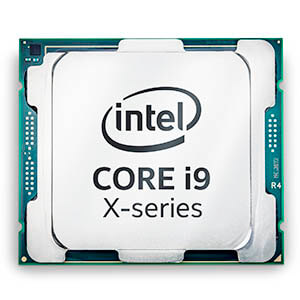
The clock frequency is 3300 MHz, but the overclocking potential is up to 4600 MHz in turbo mode. Obviously, with such a generous set of features there are some disadvantages, and that's heat dissipation: Heat dissipation is 165 W, so when choosing this crystal will definitely need a good cooling system.
The volume of the third level cache is 19.25, which is enough even with reserve.
Technical specifications:
- number of cores: 14;
- 14nm process technology;
- clock frequency: 3300 MHz;
- Number of threads: 28;
- cache size: 19.25 MB.
- high performance;
- overclocking potential;
- built-in video core;
- working speed.
- heat dissipation;
- price.
Intel Core i9-10900X.
Another high-performance tenth-generation Intel processor with ten cores on the Cascade Lake-X microarchitecture.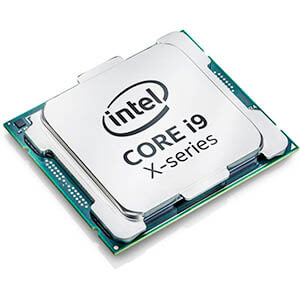
At an average workload the chip runs at 3700 MHz and does not get warmer than 70 degrees. In turbo mode, the processor can overclock to a record 4500 MHz, but the temperature will rise accordingly. Despite the presence of the cooler in the kit, it is still better to buy a more powerful cooling system, which can cope with the claimed 165 W.
Another nice thing from Intel is the AVX512 support.
Specifications:
- number of cores: 10;
- process technology: 14 nm;
- clock speed: 3700 MHz;
- number of threads: 20;
- cache size: 19.25 MB.
- high performance;
- cooler included;
- cache capacity;
- Boost overclocking up to 4500 MHz.
- heat dissipation;
- price.
Intel Core i7-7740X.
Inexpensive but productive quad-core processor based on the Kaby Lake-X microarchitecture.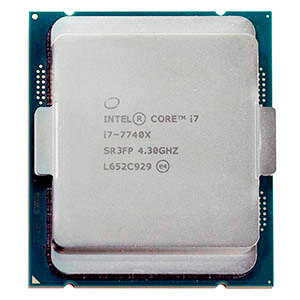
The advantage of the processor is high speed and power even when multitasking and running heavy applications. The clock frequency is not only higher than most analogs, but also exceeds the maximum turbo frequency of some processors: 4300 MHz. In turbo mode, the chip is overclocked up to 4500 MHz.
In addition, the chip supports dual-channel DDR4 memory up to 64 GB. But it has a weighty disadvantage, like all modern Intel-ins with good potential - heat dissipation (112 W).
Technical specifications:
- number of cores: 4;
- process technology: 14 nm;
- clock frequency: 4300 MHz;
- number of threads: 8;
- cache size: 8 Mb.
- fast;
- relatively inexpensive;
- good cache capacity;
- high clock frequency.
- heats up.
Top 3 best powerful Intel processors for socket 2011
The 2011 socket is suitable for high-performance computer systems and is compatible with Sandy Bridge, Ivy Bridge, Haswell, and Broadwell processors.
Intel Xeon E5-2650V2.
An excellent octa-core with good user reviews designed for powerful home computers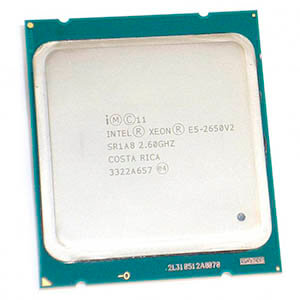
The clock frequency is 2600 MHz, but with the right device assembly and a good upgrade, the chip can show much more powerful performance. Despite the claimed heat dissipation of 130W, the processor does not heat up much, which is a plus.
In general, the processor can be called the ideal price-performance ratio for games in FullHD.
Technical specifications:
- number of cores: 8;
- process technology: 22 nm;
- clock frequency: 2600 MHz;
- cache capacity: 20 Mb.
- cache size;
- power efficiency;
- performance;
- price;
- overclocking potential.
- You need an expensive motherboard.
Intel Xeon E5-2630V2.
A great budget processor with six cores based on the Ivy Bridge-EP (2013) architecture with 22nm process technology.
The standard operating frequency of the crystal is 2600 MHz. However, users claim that if you buy a good motherboard, the processor is capable of more. At the same time, the chip does not go beyond the heat output of 80 W and is quite quiet even under heavy loads.
Layer 3 cache capacity is 15 MB. The device supports Intel vPro technology.
Technical specifications:
- number of cores: 6;
- process technology: 22 nm;
- clock frequency: 2600 MHz;
- cache size: 15 Mb.
- price;
- power and speed of operation;
- built-in memory controller;
- no heat or noise.
- none.
Intel Xeon E5-2609V2
Great hardware for a family home computer. With the right cooler, motherboard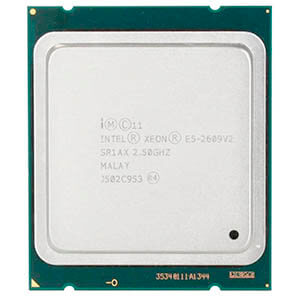
Its specifications as of 2021-2022 are quite modest, but the price is appropriate. The basis of the design are 4 cores on the architecture of Ivy Bridge-EP (2013) and 22 nm process. The operating frequency in normal mode is 2500 MHz. Officially there is no booster, but it is possible to increase the power on your own.
The model supports Intel vPro technology, has a large cache and almost no heat during operation.
Technical specifications:
- number of cores: 4;
- process technology: 22 nm;
- clock frequency: 2500 MHz;
- cache size: 10 MB.
- cheapness;
- reliability;
- performance;
- Operating frequency for everyday tasks.
- not a gamer.
Top 2 best powerful Intel processors for socket 2011v3
The 2011v3 processor socket is designed for chips with the Haswell-E/EP and Broadwell-E/EP microarchitecture.
Despite the fact that this socket is relatively old and no longer so popular, it has a significant advantage - support for 4-channel memory.
Intel Xeon E5-1630 v4
Rather simple processor with 4/8 cores and 14nm process technology provides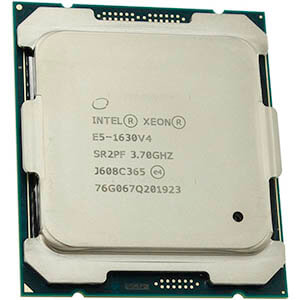
It's a good, long-lasting chip for a home computer that's good for surfing the web, word processing, desktop software and rudimentary games.
The core is based on Broadwell architecture and designed for server computers. It is overclocked up to 4000 MHz. When it comes to memory its main advantage is revealed, and, most likely, due to its high price: supported memory type is DDR4 1600/1866/2133/2400, the maximum number of channels - 4, and the volume - 1536 GB.
A significant disadvantage of the chip - heat dissipation of 140 W.
Technical specifications:
- number of cores: 4;
- 14 nm process technology;
- clock frequency: 3700 MHz;
- number of threads: 8;
- L3 cache size: 10 MB.
- good clock frequency;
- large L3 cache;
- Intel vPro support;
- works with non-ECC memory;
- stable performance.
- heat dissipation;
- no graphics core.
Intel Xeon E5-2640 v4
A powerful processor with a 10/20 core configuration and 14nm process technology shows a great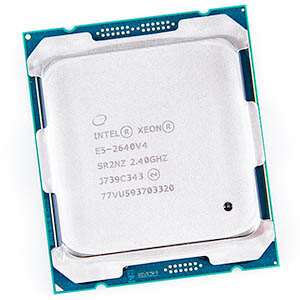
The cost of the chip has a very logical explanation - 10 cores on the Broadwell-EP microarchitecture and DDR4 memory with a maximum number of channels up to 4 and a total capacity of up to 1536 GB.
The operating frequency of the processor is 2400 MHz. There is no turbo mode, but there is support for Intel vPro technology for automatic system diagnostics. The processor also boasts of a 25 MB L3 cache size.
The typical heat dissipation is 90 W, so you need to buy a quality cooling system. No proprietary cooler is supplied.
Specifications:
- number of cores: 10;
- 14nm process technology;
- clock speed: 2400 MHz;
- Number of threads: 20;
- L3 cache size: 25MB.
- Support for DDR4 memory up to 4 channels;
- L3 cache size;
- Intel vPro support;
- performance.
- price;
- no cooler.
Top 2 best powerful Intel processors for socket 1150
The 1150 socket is suitable for Intel's Haswell and Broadwell microarchitecture processors.
Intel Core i7-4790.
A quad-core processor with 8 threads and 22nm processor designed for the LGA 1150 socket in home
Its clock frequency, 8 Mb cache and other features are enough to multitask, run heavy applications (including games) and show good performance.
The clock frequency is a solid 3600 MHz, and in Turbo mode the crystal is overclocked up to 4000 MHz. The dual-channel memory is designed for DDR3, DDR3L standards and is limited to 32 GB.
The device has an integrated graphics core HD Graphics 4600, 1200 MHz, but does not have a cooler, so you should buy an additional cooling system capable of cooling the processor with a heat dissipation of 84 W.
Specifications:
- number of cores: 4;
- process technology: 22 nm;
- clock speed: 3600 MHz;
- number of threads: 8;
- L3 cache size: 8 Mb.
- Intel vPro support;
- integrated graphics;
- two memory channels;
- power efficiency;
- performance.
- poorly overclocked;
- expensive.
Intel Core i3-4330.
Budget member of the Core i3 family is a great option for undemanding users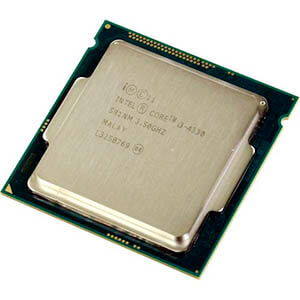
With simple games and some graphics editors chip will cope without difficulty, even in spite of the modest two cores and 22nm process technology.
The advantage of this chip, in addition to the low for 2021-2022 price, is a powerful integrated graphics core, which produces quality multimedia.
Also strengths are HyperThreading technology, minimal power consumption and excellent operating temperature with heating to a maximum of 72 degrees under heavy load.
Specifications:
- number of cores: 2;
- process technology: 22nm;
- clock frequency: 3500 MHz;
- L3 cache size: 4 Mb.
- cheapness;
- good video core;
- productive;
- NT technology.
- no cooler.
Which processor is better - AMD or Intel?
Until a while ago, Intel was the only company on the market that presented really powerful processors worthy of attention. But in 2021-2022, the young delusion of AMD has reached significant heights, learning how to create competitive models.
In terms of technical characteristics and power AMD chips are not only as good as Intel, but in some cases surpass them. At the same time AMD is much cheaper.
Shopper Testimonials
Below are customer reviews of the models presented here:
Kirill Dmitriev, Intel Core i7-3770 Ivy Bridge (3400MHz, LGA1155, L3 8192Kb):
Fast, fail-safe, hardly any heat. I have been using this particular CPU for 2 years now, never had any desire to change or replace it: even at maximum load it works without lags, you can open dozens of tabs in different browsers, games, a bunch of programs and in general everything you can think of, the crystal is great with loads and with multitasking.
Vasya Zolenko, Intel Core i5-9600KF:
Choosing an inexpensive processor for classics (conter, dota, PUBG), the key parameter for me noted FPS without jam. I have decided on Intel Cor Ai 5-9600KF and I don't regret at all: it overclocks quickly and runs stably at its usual voltage, no overheating. In games even after 2-3 hours the temperature is kept to 65 degrees, so I do not see the point of buying a processor 3 times more expensive with the same functionality.
Useful video
Comparing Intel and AMD:



